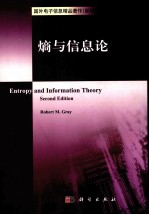

熵与信息论 英文版PDF电子书下载
- 电子书积分:14 积分如何计算积分?
- 作 者:Robert M. Gray编著
- 出 版 社:北京:科学出版社
- 出版年份:2012
- ISBN:9787030344731
- 页数:409 页
1 Information Sources 1
1.1 Probability Spaces and Random Variables 1
1.2 Random Processes and Dynamical Systems 5
1.3 Distributions 7
1.4 Standard Alphabets 12
1.5 Expectation 13
1.6 Asymptotic Mean Stationarity 16
1.7 Ergodic Properties 17
2 Pair Processes:Channels,Codes,and Couplings 21
2.1 Pair Processes 21
2.2 Channels 22
2.3 Stationarity Properties of Channels 25
2.4 Extremes:Noiseless and Completely Random Channels 29
2.5 Deterministic Channels and Sequence Coders 30
2.6 Stationary and Sliding-Block Codes 31
2.7 Block Codes 37
2.8 Random Punctuation Sequences 38
2.9 Memoryless Channels 42
2.10 Finite-Memory Channels 42
2.11 Output Mixing Channels 43
2.12 Block Independent Channels 45
2.13 Conditionally Block Independent Channels 46
2.14 Stationarizing Block Independent Channels 46
2.15 Primitive Channels 48
2.16 Additive Noise Channels 49
2.17 Markov Channels 49
2.18 Finite-State Channels and Codes 50
2.19 Cascade Channels 51
2.20 Communication Systems 52
2.21 Couplings 52
2.22 Block to Sliding-Block:The Rohlin-Kakutani Theorem 53
3 Entropy 61
3.1 Entropy and Entropy Rate 61
3.2 Divergence Inequality and Relative Entropy 65
3.3 Basic Properties of Entropy 69
3.4 Entropy Rate 78
3.5 Relative Entropy Rate 81
3.6 Conditional Entropy and Mutual Information 82
3.7 Entropy Rate Revisited 90
3.8 Markov Approximations 91
3.9 Relative Entropy Densities 93
4 The Entropy Ergodic Theorem 97
4.1 History 97
4.2 Stationary Ergodic Sources 100
4.3 Stationary Nonergodic Sources 106
4.4 AMS Sources 110
4.5 The Asymptotic Equipartition Property 114
5 Distortion and Approximation 117
5.1 Distortion Measures 117
5.2 Fidelity Criteria 120
5.3 Average Limiting Distortion 121
5.4 Communications Systems Performance 123
5.5 Optimal Performance 124
5.6 Code Approximation 124
5.7 Approximating Random Vectors and Processes 129
5.8 The Monge/Kantorovich/Vasershtein Distance 132
5.9 Variation and Distribution Distance 132
5.10 Coupling Discrete Spaces with the Hamming Distance 134
5.11 Process Distance and Approximation 135
5.12 Source Approximation and Codes 141
5.13 d-bar Continuous Channels 142
6 Distortion and Entropy 147
6.1 The Fano Inequality 147
6.2 Code Approximation and Entropy Rate 150
6.3 Pinsker's and Marton's Inequalities 152
6.4 Entropy and Isomorphism 156
6.5 Almost Lossless Source Coding 160
6.6 Asymptotically Optimal Almost Lossless Codes 168
6.7 Modeling and Simulation 169
7 Relative Entropy 173
7.1 Divergence 173
7.2 Conditional Relative Entropy 189
7.3 Limiting Entropy Densities 202
7.4 Information for General Alphabets 204
7.5 Convergence Results 216
8 Information Rates 219
8.1 Information Rates for Finite Alphabets 219
8.2 Information Rates for General Alphabets 221
8.3 A Mean Ergodic Theorem for Densities 225
8.4 Information Rates of Stationary Processes 227
8.5 The Data Processing Theorem 234
8.6 Memoryless Channels and Sources 235
9 Distortion and Information 237
9.1 The Shannon Distortion-Rate Function 237
9.2 Basic Properties 239
9.3 Process Definitions of the Distortion-Rate Function 242
9.4 The Distortion-Rate Function as a Lower Bound 250
9.5 Evaluating the Rate-Distortion Function 252
10 Relative Entropy Rates 265
10.1 Relative Entropy Densities and Rates 265
10.2 Markov Dominating Measures 268
10.3 Stationary Processes 272
10.4 Mean Ergodic Theorems 275
11 Ergodic Theorems for Densities 281
11.1 Stationary Ergodic Sources 281
11.2 Stationary Nonergodic Sources 286
11.3 AMS Sources 290
11.4 Ergodic Theorems for Information Densities 293
12 Source Coding Theorems 295
12.1 Source Coding and Channel Coding 295
12.2 Block Source Codes for AMS Sources 296
12.3 Block Source Code Mismatch 307
12.4 Block Coding Stationary Sources 310
12.5 Block Coding AMS Ergodic Sources 312
12.6 Subadditive Fidelity Criteria 319
12.7 Asynchronous Block Codes 321
12.8 Sliding-Block Source Codes 323
12.9 A Geometric Interpretation 333
13 Properties of Good Source Codes 335
13.1 Optimal and Asymptotically Optimal Codes 335
13.2 Block Codes 337
13.3 Sliding-Block Codes 343
14 Coding for Noisy Channels 359
14.1 Noisy Channels 359
14.2 Feinstein's Lemma 361
14.3 Feinstein's Theorem 364
14.4 Channel Capacity 367
14.5 Robust Block Codes 372
14.6 Block Coding Theorems for Noisy Channels 375
14.7 Joint Source and Channel Block Codes 377
14.8 Synchronizing Block Channel Codes 380
14.9 Sliding-block Source and Channel Coding 384
References 395
Index 405
- 《管理信息系统习题集》郭晓军 2016
- 《信息系统安全技术管理策略 信息安全经济学视角》赵柳榕著 2020
- 《卓有成效的管理者 中英文双语版》(美)彼得·德鲁克许是祥译;那国毅审校 2019
- 《ESG指标管理与信息披露指南》管竹笋,林波,代奕波主编 2019
- 《AutoCAD 2018自学视频教程 标准版 中文版》CAD/CAM/CAE技术联盟 2019
- 《跟孩子一起看图学英文》张紫颖著 2019
- 《大学计算机信息技术教程 2018版》张福炎 2018
- 《大数据环境下的信息管理方法技术与服务创新丛书 俄罗斯档案事业改革与发展研究》徐胡乡责编;肖秋会 2019
- 《AutoCAD机械设计实例精解 2019中文版》北京兆迪科技有限公司编著 2019
- 《交通工程安全风险管控与隐患排查一体化理论方法与信息化管理技术》王海燕著 2019
- 《市政工程基础》杨岚编著 2009
- 《家畜百宝 猪、牛、羊、鸡的综合利用》山西省商业厅组织技术处编著 1959
- 《《道德经》200句》崇贤书院编著 2018
- 《高级英语阅读与听说教程》刘秀梅编著 2019
- 《计算机网络与通信基础》谢雨飞,田启川编著 2019
- 《社会学与人类生活 社会问题解析 第11版》(美)James M. Henslin(詹姆斯·M. 汉斯林) 2019
- 《看图自学吉他弹唱教程》陈飞编著 2019
- 《法语词汇认知联想记忆法》刘莲编著 2020
- 《培智学校义务教育实验教科书教师教学用书 生活适应 二年级 上》人民教育出版社,课程教材研究所,特殊教育课程教材研究中心编著 2019
- 《国家社科基金项目申报规范 技巧与案例 第3版 2020》文传浩,夏宇编著 2019
- 《指向核心素养 北京十一学校名师教学设计 英语 七年级 上 配人教版》周志英总主编 2019
- 《《走近科学》精选丛书 中国UFO悬案调查》郭之文 2019
- 《北京生态环境保护》《北京环境保护丛书》编委会编著 2018
- 《中医骨伤科学》赵文海,张俐,温建民著 2017
- 《美国小学分级阅读 二级D 地球科学&物质科学》本书编委会 2016
- 《指向核心素养 北京十一学校名师教学设计 英语 九年级 上 配人教版》周志英总主编 2019
- 《强磁场下的基础科学问题》中国科学院编 2020
- 《小牛顿科学故事馆 进化论的故事》小牛顿科学教育公司编辑团队 2018
- 《小牛顿科学故事馆 医学的故事》小牛顿科学教育公司编辑团队 2018
- 《高等院校旅游专业系列教材 旅游企业岗位培训系列教材 新编北京导游英语》杨昆,鄢莉,谭明华 2019
